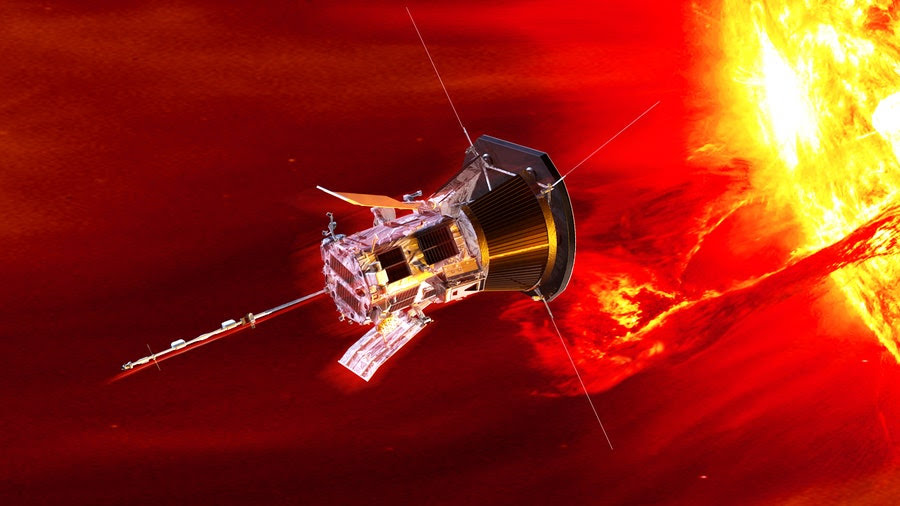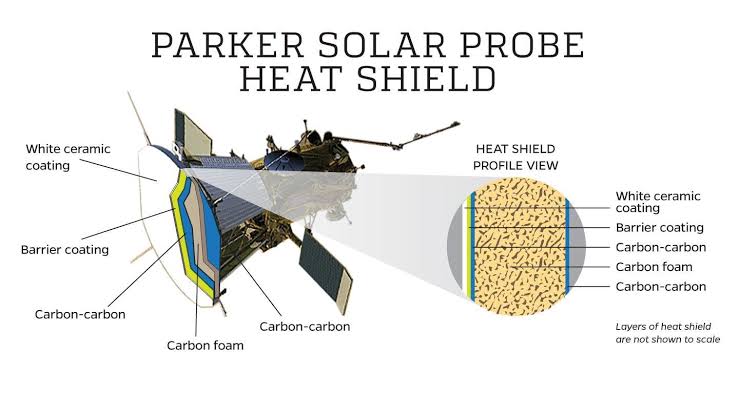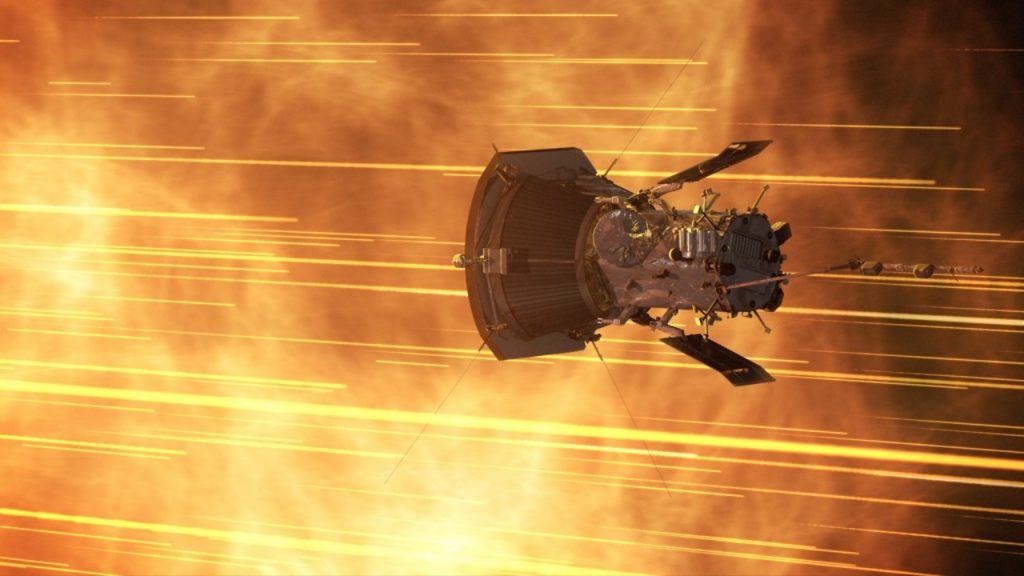The Wright brothers achieved the first controlled, sustained, and powered flight in December 1903, ushering in the age of aviation. Humans have now reached out and touched the Sun, a little over a century later. The Parker Solar probe was the first device created by humans to penetrate the Sun’s corona or outer atmosphere.
The spacecraft collected particles and magnetic fields emerging from the Sun during its perilous first journey, which has long piqued the interest of scientists across the world.
The probe’s entrance into the solar system, which has been compared to the Moon landings, is expected to reveal previously unknown details of our solar system’s largest star.
Touching the Sun with the Parker Solar probe is a watershed event in solar research and a really extraordinary achievement.
Not only does this achievement give us a better understanding of our Sun’s evolution and impact on our solar system, but everything we learn about our own star also educates us about all of the stars in the cosmos Thomas Zurbuchen, Nasa’s deputy president for the Science Mission Directorate, stated.
What is the Parker Solar Probe and How Does It Work?
The Parker Solar probe was launched in 2018 to investigate our Sun’s enigmatic universe. The spacecraft, named for American solar scientist Eugene Parker, is attempting to solve the secrets of our Sun.
It will fly through the Core of the sun at a distance of 3.8 million miles from our star’s surface, passing within Mercury’s orbit and coming closer than any previous flight.
The spacecraft will approach the Sun near enough to see the solar wind speeding up from subsonic to supersonic, as well as pass through the area where the highest-energy solar particles are created.
The spacecraft and equipment are being shielded from the Sun’s heat by a 4.5-inch thick carbon-composite shield, which can endure temperatures outside the spacecraft of approximately 1,377 degrees Celsius, according to Nasa.
Why won’t it melt? How NASA’s Solar probe will survive the Sun?
Knowing the notion of heat vs temperature is one of the keys to understanding what makes the spacecraft and its equipment safe. Surprisingly, high temperatures do not necessarily imply that another item is being heated.
Temperatures in space may reach thousands of degrees without giving considerable heat to a specific item or making one feel warm. Why? Temperature is a measure of how rapidly particles move, whereas heat is a measure of how much energy they convey.
Particles may move quickly, but if there aren’t many of them, they won’t be able to transfer much energy. There are extremely few particles that may transfer energy to the spacecraft since space is essentially empty.
For example, the plasma through which the Parker Solar Probe traverses has a high temperature but a low density. Consider the difference between sticking your hand in a hot oven and a pot of boiling water Your hand can survive substantially higher temperatures in the oven for longer periods than it can in the water, where it must deal with many more particles.
Similarly, the corona is less thick than the visible surface of the Sun, so the spacecraft encounters fewer hot particles and receives less heat.
Whereas the Parker Solar Probe will be traveling through space at high temperatures a million degrees Fahrenheit, the heat shield’s surface facing the Sun will only be heated to around 2,500 degrees F (about 1,400 degrees Celsius).
Related: Plasma bursts on Parker Solar Probe are caused by hypervelocity dust strikes
The Barrier That Keeps It Safe
Of course, temperatures of the hundreds of degrees Fahrenheit are still quite hot. (Lava from volcano eruptions may range in temperature from 1,300 to 2,200 degrees Fahrenheit) (700 and 1,200 C) Parker Solar Probe has a heat barrier called the Thermal Protection System, or TPS, that is 8 feet (2.4 meters) in diameter and 4.5 inches (approximately 115 mm) thick to resist the heat. The spaceship body will be at a pleasant 85 degrees Fahrenheit just on the other side of the shield, thanks to those few inches of protection (30 C).
The TPS was created by Carbon-Carbon Advanced Technologies utilizing a carbon composite foam sandwiched between two carbon plates, as planned by the Johns Hopkins Applied Physics Laboratory.
To reflect as much heat as possible, this lightweight insulation will be coated with a final coat of white ceramic paint on the sun-facing plate. The TPS has been tested to resist temperatures of up to 3,000 degrees Fahrenheit (1,650 degrees Celsius), ensuring that practically all instrumentation remains safe.
The Wind Cup is a cup that measures how strong the wind is
However, the TPS will not have all of the Solar Parker Probe equipment. The Solar Probe Cup, which protrudes over the heat shield, is one of two instruments aboard Parker Solar Probe that will not be shielded by the heat shield.
This device is a Faraday cup, which is a sensor that measures ion and electron fluxes as well as flow angles in the solar wind. Due to the harshness of the solar environment, special technologies were developed to ensure that not only the instrument would survive, but that the electronics onboard would also be able to relay back precise results.
Sheets of Tungsten, a molybdenum alloy with a melting point of 4,260 degrees Fahrenheit, are used to construct the cup (2,349 C). The grids for the Solar Probe Cup’s electromagnetic current are made of tungsten, a metal with a melting temperature of 6,192 degrees Fahrenheit (3,422 C). Normally, lasers are used to etch the gridlines in these grids, but acid had to be used instead owing to the high melting point.
Another issue was the electronics wiring: most wires would melt if they were exposed to heat radiation at that close range to the Sun. The researchers used sapphire crystal tubes to hang the wiring and niobium wires to overcome the problem.
Also read: What would happen to the solar system if the Sun disappeared?
Into that (solar) storm’s eye
In April, during the spacecraft’s eighth near encounter with the sun, the Parker Solar Probe went into and out of the corona numerous times during the initial flyby.
At 18.8 solar radii (approximately 8.1 million miles) above the solar surface, the spacecraft experienced particular magnetic and particle conditions, indicating that it had passed the Alfvén critical surface For the first time, the spacecraft has entered the solar atmosphere.
When the Parker Solar Probe approached 15 solar radii (about 6.5 million miles) from the Sun’s surface, it passed through a pseudostreamer in the corona. Pseudostreamers are massive formations that rise above the Sun’s surface and may be observed from Earth during solar eclipses.
The spacecraft came into contact with an area where the magnetic fields were strong enough to control particle movement. The initial trip through the corona, which lasted only a few hours, is one of several planned for the project, according to Nasa.
The spaceship will continue to spiral near the sun until it is 8.86 solar radii away from the surface (3.83 million miles). The Sun’s next flyby is expected for January 2022.
Taking Off Towards the Sun
The probe will identify the Sun’s location after launch, arrange the thermal protection shield to face it, and continue its voyage over the following three months, enjoying the Sun’s heat while avoiding the chilly emptiness of space.
The spacecraft will orbit our star 24 times throughout the length of the projected seven-year mission. It will sample the solar wind, investigate the Sun’s corona, and give unprecedentedly close-up observations from around our star on each near visit — and we know it will retain its cool the entire time thanks to its suite of unique technologies.
Is it possible that the Parker Solar Probe will collide with the Sun?
Parker Solar Probe will be speeding around the Sun at 430,000 kilometers per hour during its closest approach! That’s quick enough to go from Philadelphia to Washington, D.C. in a fraction of a second.
The Parker Solar Probe will travel within 4 million miles of the Sun’s surface, exposing itself to heat and radiation in a way that no previous mission has done before. Parker Solar Probe, which was launched on August 12, 2018, will offer fresh data on solar activity and contribute to our capacity to anticipate big space-weather events that affect life on Earth.
What temperature will the Parker probe reach?
The front of the Parker Solar Probe’s solar shield is exposed to temperatures surpassing 2,500 degrees Fahrenheit when it is closest to the Sun (1,377 C). The cargo of the spaceship will be close to room temperature.
What is the quickest item created by humans?
As it ‘touches down on the surface of the sun, NASA’s solar probe becomes the fastest object ever made. 244,255 mph (393,044 km/h) is the fastest human-made item. The spacecraft that is closest to the sun is 11.6 million miles away (18.6 million kilometers)
Is NASA attempting to touch the sun?
The sun, unlike Humanity, does not really have a solid surface. The spacecraft successfully “touched” the sun when it entered the outer atmosphere, according to NASA. The mission’s project scientist is Nour Raouafi. In Maryland, he works at the Johns Hopkins Applied Physics Laboratory.
Conclusion
When Nasa’s Parker Solar Probe reached the solar system in April of this year, it became the first human-made object to contact the Sun. Nasa revealed data from the probe on Wednesday, showing that it reached within 1.3 million kilometers of the Sun’s surface. Two high-temperature carbon-carbon advanced composites sandwich a 4.5-inch-thick composite foam core make up the Parker Solar Probe’s shell.
——————————————
Resent posts:



